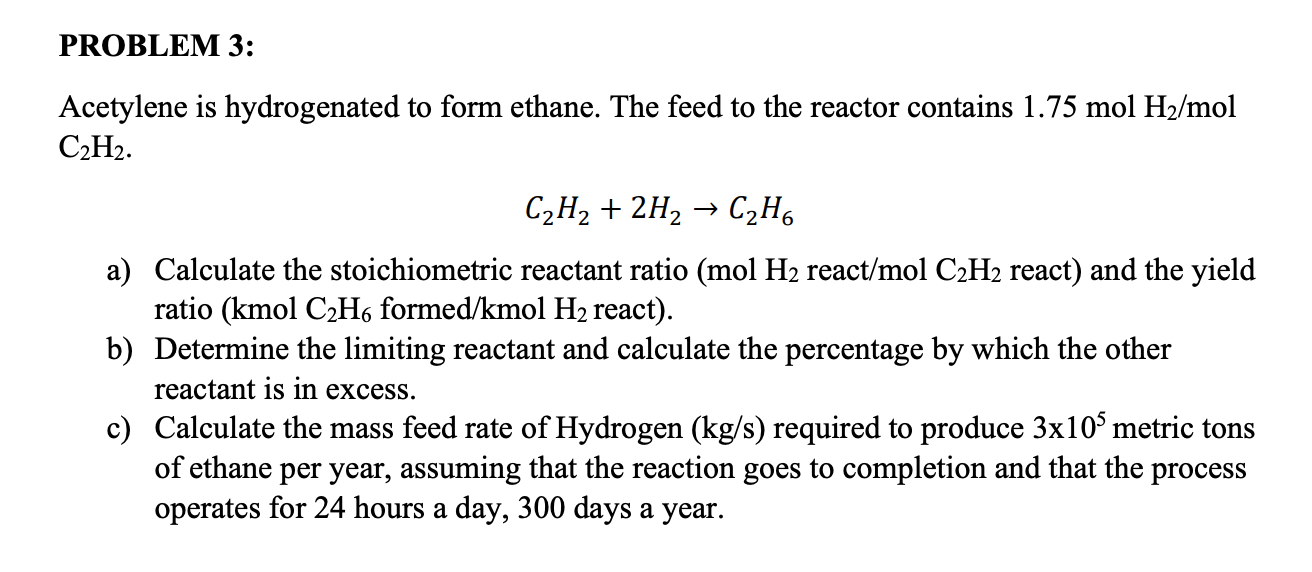Acetylene Is Hydrogenated To Form Ethane
Acetylene Is Hydrogenated To Form Ethane - Web acetylene is hydrogenated to form ethane. The feed to the reactor contains 1.50molh2/molc2h2 1.50 m o l h 2 / m o l c 2 h 2. (marks 20) acetylene (c2h2) is hydrogenated to form ethane (c2h6). The feed to the reactor contains 1.40 mol h2/mol c2h2. The reaction proceeds to completion. A) write the balanced chemical reaction for this process. Web the hydrogen atoms in acetylene can be replaced by metallic elements to form acetylides—e.g., acetylides of silver, copper, or sodium. Acetylene is hydrogenated to form ethane (c2h6). In chemical reactions, the limiting reactant is the reactant that is completely consumed and determines when the reaction stops. Write the stoichiometric equation for this reaction, and then answer the following questions:
Find all video solutions for your textbook. In the ethane molecule, the bonding picture according to valence orbital theory is very similar to that of methane. Write the stoichiometric equation for this reaction, and then answer the following questions: Web the limiting reactant in the hydrogenation of acetylene to ethane, with feed containing 1.4 mol h2/mol c2h2, is acetylene (c2h2). (a) calculate the stoichiometric reactant ratio (mol h2 h 2 react/mol c2h2 c 2 h 2 react) and the yield ratio (kmol c2h6 c 2 h 6 formed/kmol h2 h 2 react. Web the hydrogen atoms in acetylene can be replaced by metallic elements to form acetylides—e.g., acetylides of silver, copper, or sodium. The feed to the reactor contains 1.50 mol h2/mol c2h2.
Web hydrogenation of gas mixtures enriched in acetylene and hydrogen in which acetylene is not an impurity, but the main component that needs to be quantitatively converted into ethylene, is also of great scientific and practical interest. The feed to the reactor contains 1.50 \mathrm {mol} \mathrm {h}_ {2} / \mathrm {mol} 1.50molh2/mol \mathrm {c}_ {2} \mathrm {h}_ {2} c2h2. Web acetylene is hydrogenated to form ethane. The feed to the reactor contains 1.50 mol h_2/mol c_2h_2. In chemical reactions, the limiting reactant is the reactant that is completely consumed and determines when the reaction stops.
Web over fe 2 o 3 cluster, the overall barriers for h 2 dissociation, addition reaction of two hydrogen atom are respectively 26.6, 32 and 31.8 kcal·mol −1 during the acetylene hydrogenation to form ethylene and 26.5, 35.5 and 9.1 kcal·mol −1 for its further hydrogenation to produce ethane. Web write the balanced equation for the reaction of acetylene and hydrogen to form ethane. Conventional thermal hydrogenation routes require. The feed to the reactor contains 1.50 mol h2/mol c2h2. Calculate the stoichiometric reactant ratio (mol h2 reacted/mol c2h2 reacted) and the yield ratio (mol czhs formed/mol h2 reacted). In chemical reactions, the limiting reactant is the reactant that is completely consumed and determines when the reaction stops.
Calculate the stoichiometric reactant ratio (mol h2 react/molc2h2 react) and the yield ration (. The reaction proceeds to completion. The feed to the reactor contains 2.25 moles of h_2 for every mole of c_2h_2. The feed to the reactor contains 1.30 mol h2/mol c2h2. In the ethane molecule, the bonding picture according to valence orbital theory is very similar to that of methane.
Find all video solutions for your textbook. The reaction proceeds to completion. A) write the balanced chemical reaction for this process. Write the stoichiometric equation for this reaction, and then answer the following questions:
Web Write The Balanced Equation For The Reaction Of Acetylene And Hydrogen To Form Ethane.
We have the balanced reaction as follows: Web acetylene is hydrogenated to form ethane in the following reaction c2h2 + 2h2 → c2h6. Acetylene is hydrogenated to form ethane (c2h6). The feed to the reactor contains 1.50 mol h2/mol c2h2.
The Feed To The Reactor Contains 1.50 Mol H2 /Mol C2H2.
The feed to thereactor contains 1.5 mol h2/mol c2h2.a. (a) calculate the stoichiometric reactant ratio (mol h2 h 2 react/mol c2h2 c 2 h 2 react) and the yield ratio (kmol c2h6 c 2 h 6 formed/kmol h2 h 2 react. In chemical reactions, the limiting reactant is the reactant that is completely consumed and determines when the reaction stops. Web acetylene is hyrodgenated to form ethane.
Web Acetylene Is Hydrogenated To Form Ethane.
Calculate the stoichiometric reactant ratio (mol h2 react/molc2h2 react) and the yield ration (. Web chemistry questions and answers. The acetylides of silver, copper, mercury, and gold are detonated by heat, friction, or shock. (a) calculate the stoichiometric reactant ratio (mol h2 react/mol c2h2 react) and the stoichiometric yield ratio (kmol c2h6 formed/kmol h2 react).
The Feed To The Reactor Contains 1.50 Mol H_2/Mol C_2H_2.
A) write the balanced chemical reaction for this process. Write the stoichiometric equation for this reaction, and then answer the following questions: 0.7 mol h2 reacted/mol c2h2 reacted 0.5 mol c2hs formed/mol h2 reacted b. Web acetylene is hydrogenated to form ethane in the following reaction c2h2 + 2h2 → c2h6.






